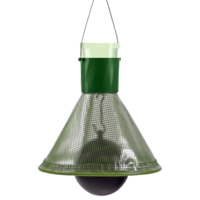Horse flies are a constant nuisance, especially in the period May - October. Their larvae hibernate in humid environments such as watercourses, lakes, ponds or swamps. Adult horse flies appear in April and then become a nuisance for horses, cattle and humans. When they feed on blood, their aggressive stings are considered very painful. For both animals (such as horses, cows) and people, it is not a pleasant feeling. The orginal horse fly traps effectively controls the number of horse flies and reduces them to an absolute minimum. The trap is set up outside and works without the use of chemicals and / or electricity.
How does it work?
The horse fly finds its prey with the eyes - not with the sense of smell. The horse flies are attracted by the movement of the ball in the wind and by the heat generated by solar radiation. They confuse the black ball with a living animal, such as a horse. Once they are positioned on the black ball, they will investigate it and try to sting it. Since the horse fly are among the few animals that fly upwards, the horse fly automatically gets into a centrally placed collection bin from which they cannot break out and drown.
Watch this informative video about the H-trap:
How to get the most out of the trap
- In order to maximize the success of catching the flies, set the preferred trap between the humid areas (such as ponds, river banks, etc.) and the areas where humans and animals reside.
- Place the brake catch (s) between these areas, placing them closer to the places where the animals are located.
- Place the trap early, preferably just before the horse flies fly in April.
- Check the traps weekly, empty or fill with soapy water if necessary.
- If the brake trap does not catch a sufficient number of flies, and you are certain that adult flies exist, change the location of the trap.
Discover the original horse fly traps above.
What are horsefly traps?
Horsefly traps are devices designed to capture and control horseflies, also known as deer flies or clegs. These pests can be a nuisance to livestock and humans, and their bites can be painful and potentially transmit diseases.
The advantage of horsefly traps?
The advantages of horsefly traps are that they are environmentally friendly, non-toxic, and effective at reducing the population of horseflies in a specific area. They are also easy to use and require little maintenance.
How do horsefly traps work?
Horsefly traps work by using visual and olfactory cues to attract the flies. Typically, these traps are designed with a black ball or other shapes that mimic the appearance of a large animal's eyes, which the horseflies mistake as a potential host. The trap also emits carbon dioxide or other substances that mimic the smell of warm-blooded animals, which further attracts the flies. Once they approach the trap, they get caught in a sticky substance or sucked into a net.
Tips for determining the best horsefly trap
When determining the best horsefly trap for you, consider factors such as the size of the area you want to cover, the number of horseflies you're dealing with, and your budget. Some traps may be more effective for larger areas, while others are designed for smaller spaces.
How do you install a horsefly trap?
To install a horsefly trap, place it in a sunny location, preferably near water or an area where horseflies are known to congregate. Follow the manufacturer's instructions for specific installation and maintenance requirements.
What attracts horseflies?
Horseflies are attracted to visual and olfactory cues, including the color black, movement, carbon dioxide, and the scent of warm-blooded animals, including humans and horses.

